|
Co-sponsors of the 2023 Winning Out
Certificates


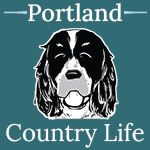
| |
Co-ordination and balance
Good co-ordination and balance are absolutely essential for agility
dogs. Some dogs are born with it; others develop it as they learn about agility. But what about
the ones that find it more difficult? Should we just point them at agility equipment and cross
our fingers? Maybe after falling off some contact equipment, or after crashing into something,
they will be a bit more careful next time. Hang on a minute. Do we really want to let that
happen even once? Hannah Banks asks, 'Can we do anything to help them more?
|
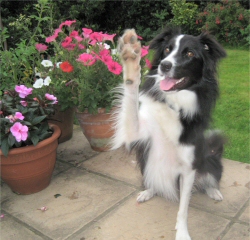 I
have been surprised that so many dogs don't pay much attention to what their back legs
are doing, but then why should they? In the course of canine evolution, racing along high
narrow planks and stopping at the bottom, negotiating twisting jumping courses at high
speeds, weaving, and so on, are extremely recent requirements! I
have been surprised that so many dogs don't pay much attention to what their back legs
are doing, but then why should they? In the course of canine evolution, racing along high
narrow planks and stopping at the bottom, negotiating twisting jumping courses at high
speeds, weaving, and so on, are extremely recent requirements!
All these
thoughts were running through my head when I got a puppy. Just like everyone else who has
a new bundle of joy in their lives, I want to do the best for my little ray of sunshine
as she grows up. I wondered if I could pre-prepare her for her for what I hope will be a
long and happy agility career. However, I worry that too much jarring, repetitive
movement or hard knocks might cause damage to developing joints. I would not want to take
any chances with her physical or mental development or long term health and fitness. I do
not want to start her on agility equipment too soon.
With all the
above in mind, and because I see so many dogs that struggle physically with the high
degree of balance and co-ordination required to negotiate agility equipment when first
introduced to it, I began to find out about various ways that we can help our dogs bridge
the gap between running around chasing the odd squirrel, and taking part in the rather
more demanding sport of agility. It turns out that there are a number of exercises that
your dog can do that do not require any jarring, jumping or twisting movements. They will
help muscular development and assist him/her to become better co-ordinated and balanced.
In some cases, they make use of already quite familiar movements, but is more a case of
'it's not what you do it's the way that you do it!' was a little sceptical of the
usefulness of other 'tricks' at first, until I tried them out. The results I have seen so
far have been impressive.
I now have at
least ten different types of exercise that involve both movements and skills that are
easily taught without equipment, plus some using equipment or obstacles that you might
already have around the house or could obtain or put together reasonably easily. They are
suitable for all types of dog, and most can be done at home. They are controlled and
gentle, focus and concentrate the dogs energy, and teach the dog new skills, as well as
improving balanced movement and co-ordination. |
Foundations of Co-ordination &
Balance for Agility Dogs Workshop
This training day has been designed
to provide training and exercises for dogs to promote correct movement, balance and
co-ordination, which are the fundamental requirements for optimal agility performance.
No agility equipment will be used.
All movements will be gentle and controlled. They will not involve impact, stress or
excessive twisting. This training day will be particularly suitable as a pre-agility
foundation course for young dogs, or for physical preparation for dogs that are coming
back to agility after a break, or for dogs that knock poles, are poorly co-ordinated, or
would generally benefit from developing more balance and efficiency of movement.
Venue: Sunbury (Surrey)
Time: Between 9:30am-12:30pm
Cost: £25 each
For more information, email Hannah Banks
h.banks@rbgkew.org.uk or ring mobile:
07904 368044 |
I have seen dogs show
massive improvement after only one lesson!
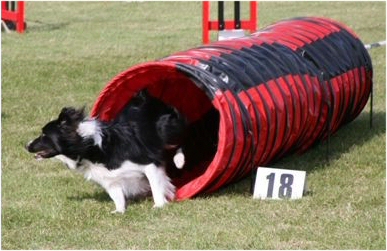 Many
of the exercises could also be later incorporated into a warm up routine once agility training
starts. You could even do some of them in front of the tele! The longer term benefits of
focussing on improving balance and co-ordination as a pre-agility foundation will enable dogs
to: Many
of the exercises could also be later incorporated into a warm up routine once agility training
starts. You could even do some of them in front of the tele! The longer term benefits of
focussing on improving balance and co-ordination as a pre-agility foundation will enable dogs
to:
-
Find agility
obstacles easier to negotiate, which means that as they are trained, they will get it right
more often, get rewarded more, and subsequently learn and progress faster.
-
Find fast, accurate
movements easier, resulting in a reduced chance of hitting equipment awkwardly, reducing the
chance of accidents and injury, reducing the possibility of knocked poles, and producing more
accurate, controlled negotiation of contact equipment.
Most of all, though,
these exercises are fun and safe new games that build your relationship with your dog, as well
as teaching it new skills that will enable it to become an agile athlete.
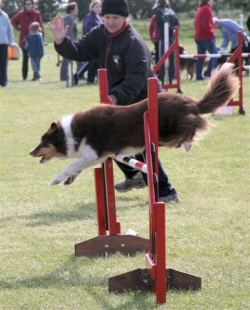 About
the author... About
the author...
Hannah
Banks first had a go at agility nearly ten years ago, when her boyfriend's energetic,
unruly collie came to live with her. They only discovered agility because they were asked to
leave the obedience class, which was the first place that she tried taking him for training!
Boogie - that's the dog, not the boyfriend - got on much better with agility than obedience,
but although he is now retired.
Hannah, however, was
well and truly bitten by the agility bug so she went on to get a collie puppy bitch, Becky (Wildkap
Wannabe). Although Becky was hesitant and unconfident to start with, has a rather odd jumping
action, and is actually not that keen on running around much apart from when she's doing
agility, they eventually found a system that worked. Becky now competes at grade 7, has
qualified for Olympia twice, Crufts twice, won the 2005 senior point's league both in the
Agility Eye Awards and Agility Voice Awards, has won hundreds of trophies, qualified for many
finals, won the senior DIN final, has come second in the advanced Supadogs final, had three
reserve championship certificates and one championship win.
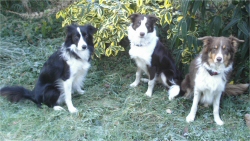 Then
along came Kaydee (Waggerland Wildcard) now three years old. After a nasty accident that
knocked her back out of alignment at 16 months, Kaydee might never have been sound again
without the help of the brilliant chiropractor Marisa Pinnock. Hannah and Kaydee make a perfect
pair, as Hannah also sought chiropractic treatment to ‘fix' her own dodgey back! Kaydee now
competes at Grade 6, but throughout 2007 has been plagued by the 'one pole every run' syndrome.
Hannah has started taking Kaydee through a balance and co-ordination exercise programme and is
hopeful that fewer poles will fall next year. Then
along came Kaydee (Waggerland Wildcard) now three years old. After a nasty accident that
knocked her back out of alignment at 16 months, Kaydee might never have been sound again
without the help of the brilliant chiropractor Marisa Pinnock. Hannah and Kaydee make a perfect
pair, as Hannah also sought chiropractic treatment to ‘fix' her own dodgey back! Kaydee now
competes at Grade 6, but throughout 2007 has been plagued by the 'one pole every run' syndrome.
Hannah has started taking Kaydee through a balance and co-ordination exercise programme and is
hopeful that fewer poles will fall next year.
A new puppy, Zazzy,
appeared in the middle of 2007. Hannah is working on the principle of accuracy before speed, so
it will be interesting to see what difference it makes in the long run, working on the way
Zazzy moves before she even meets any agility equipment.
For a day job, Hannah
carries out research on pollen structure for the Royal Botanic Gardens, Kew. It seems that
while proficient with electron microscopes, she is better at choosing vans for their pretty
white colour rather then any mechanical soundness.
| |
|